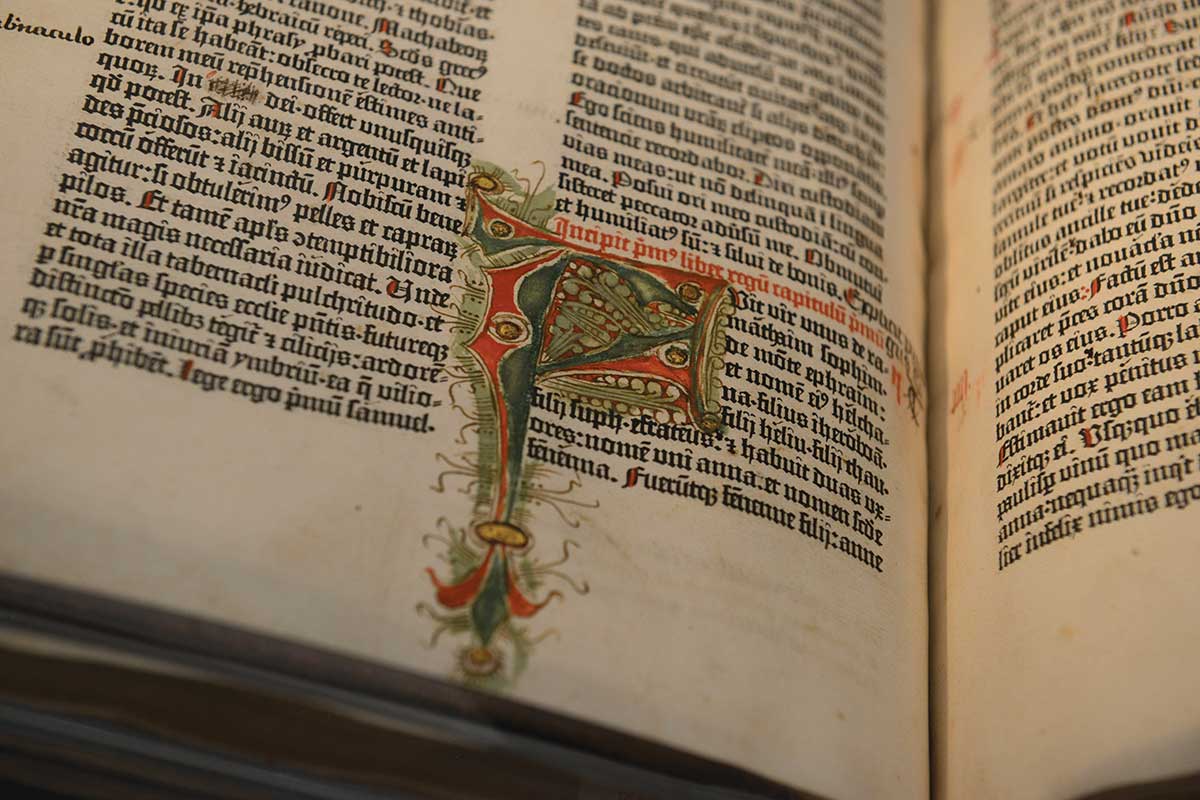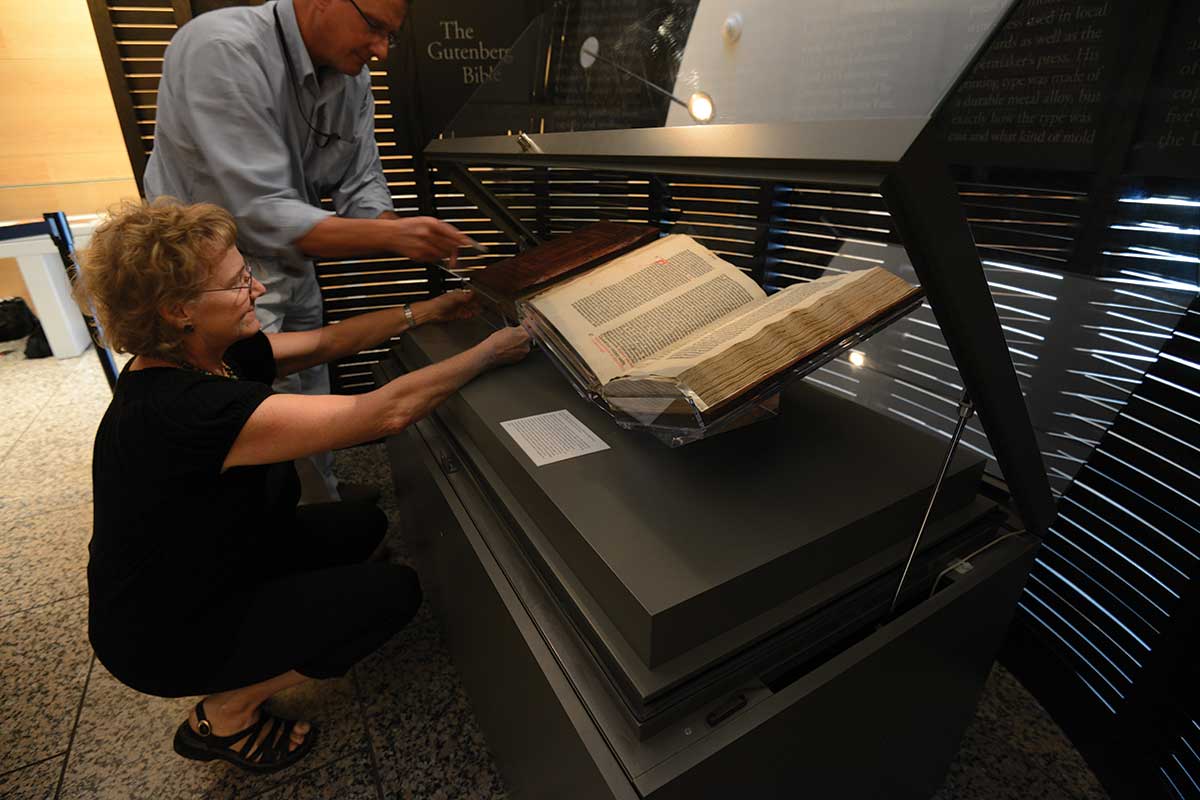Olivia Primanis lifts the open Gutenberg Bible from its cradle with her bare hands. The senior book conservator at the Harry Ransom Center removes the more than 550-year-old text from the display case at the University of Texas at Austin and closes the polished calfskin binding, handling the rare book with as much ease as an everyday Merriam-Webster dictionary.
“It doesn’t help if you get nervous,” Primanis says, explaining her respect for historic manuscripts. “So many of the things we have here have been touched by the creator … and so we’ve always realized the importance of the artifact.”
In late summer, she and a team are updating the Bible exhibit in the humanities and research library and museum by changing the displayed page of the university’s copy of this epic tome. Produced in about 1455, the Gutenberg Bible was the first surviving book printed on a printing press with moveable type.
Johann Gutenberg invented the printing press and process in Germany, and the first book he printed commercially was the Bible. The approximately 180 books printed in his print shop are now called Gutenberg Bibles.
The printing press revolutionized the reproduction of the printed word. Books that once had to be hand copied could now be produced with speed and accuracy through a mechanical process. The subsequent availability of printed texts, starting with the Gutenberg Bible, put knowledge at mankind’s fingertips.
“And ownership of and access to printed texts of all sorts has been incomparably the most significant factor in human intellectual progress over the past five centuries,” writes Martin Davies, a curator of the British Library, in “The Gutenberg Bible” (British Library Board, 1996).
Only about 48 Gutenberg Bibles survive today. The book Primanis holds in her arms during the Ransom Center’s quarterly page-turning is one of only five complete Gutenberg Bibles in the United States.
The Gutenberg Bible is also “the central text of the religion of the West, the book of books, the source of faith and its palpable expression,” writes Davies. “In its earliest printing it is also, in the opinion of many critics, one of the most beautiful books ever produced.”

Hand-drawn embellishments adorn the first-surviving book printed using movable type.
Jeff Joiner
That beauty is subtly on display at the Ransom Center. Two volumes make up the complete text of UT’s copy, with each book measuring about 16 inches tall, 11 ½ inches wide and 4 inches thick, and weighing more than 14 pounds. Most days, they rest—one open, one closed—in a secure and climate-controlled case in the lobby where the “display is all about control of light,” explains Ken Grant, exhibition conservator and head of exhibition services.
Even under subdued lanterns, the polished calfskin cover of the closed book gleams, and the open book reveals two of the complete work’s more than 1,277 printed pages of still-supple paper, handmade with organic fibers in northern Italy by craftsmen who “knew intuitively what made a good piece of paper,” Grant says, rubbing his thumb and fingers together. “They knew how to make things last.”
Each leaf of the hardy paper stock had to withstand about four passes through Gutenberg’s invention. The mechanism, perhaps modeled after a winepress, imprinted rows of rich black Gothic letters that spell out the Vulgate, or St. Jerome Latin translation of the Bible, common in Gutenberg’s time.
Hundreds of characters—cast in metal in reverse so they could be aligned backward in a frame, dabbed with ink and then pressed on paper—appear woven into two columns of 40, 41 or 42 lines in the Texas copy. The old-fashioned lettering and lack of most punctuation makes the text nearly unreadable to a modern observer even if one did know archaic Latin. Yet the text was by medieval standards “very neat and legible … not at all difficult to follow … without glasses,” according to a letter written in 1455.
Hand-drawn embellishments grace the lettering. They include “illuminations” painted in gold leaf and bold, old-world colors on select initial letters; rubrication, or red detailing at the beginning of sentences; and liturgical directions and corrections in the margins.
Handwriting studies hint at the two volumes’ ownership over the past five centuries, wrote Eric Marshall White of Southern Methodist University’s Bridwell Library in a description and analysis of UT’s Gutenberg Bible. Four scribes wrote in the texts, but only one person, in about 1600, wrote in both, meaning the two volumes are not an original pair.
Clues from the bindings suggest the Texas texts might have served German Jesuits and remote Carthusian monks, White reports, but little is known of this copy’s early history. In the early 1800s, the copy moved to the first-recorded individual owners, traveling from a European book collector to a prince, two earls, a library and, finally, to the private collection of the Pforzheimer family in New York City in the 1920s.
The University of Texas purchased the Gutenberg Bible from the Carl and Lily Pforzheimer Foundation for $2.4 million in 1978. For more than 35 years, the incunabulum—a book printed before 1501—has been on nearly constant display at the Ransom Center.
Primanis has been involved with turning the page for the Gutenberg Bible display for 23 of those years. Before UT’s fall 2013 semester, she places Volume II that had been open to Lamentations on a utility cart near the display with an ease that comes from experience. She takes Volume I from the display case and rests it on its spine beside the second.
She turns to Ryan Hildebrand, book cataloging department head and curator of the Pforzheimer collection at UT, for confirmation of the page number he says he chose based on personal interest and physical features of the book. “And it’s 121?” Primanis asks.
“One twenty-eight,” Hildebrand instructs, bending to see the penciled-in page numbers, added to the upper corners as a modern study aid, as Primanis thumbs through the book. They’re looking for the end of Ruth and the beginning of I Samuel, where in this copy the number of lines per column changes from 42 to 40 as Gutenberg adjusted the printing process to conserve paper.
Finding Page 128, Primanis supports the open book on her forearms and places it on the display next to Volume II, which she had closed and replaced earlier. She pliés to get eye level with the book and slides two supports below the pages to prevent drooping. Then she, Grant and Hildebrand step back in admiration of the artifact that she—and the creator—has touched.


